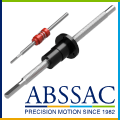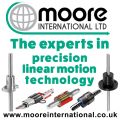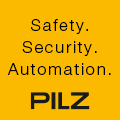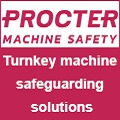
Posted to News on 25th Oct 2018, 18:08
Smart safety, Industry 4.0 and higher productivity
Together with the protection of people and the environment, smart safety can deliver multiple benefits to manufacturing companies. When safety devices and mechanisms are interconnected throughout the plant, safety compliance can be achieved more easily while productivity, performance and profitability are also improved.
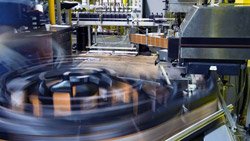
Today, it is much easier to have access to real-time data provided by safety systems. Open, standardised networks provide connectivity between safety and other systems - and the data they provide does much more than minimise the risk of worker injury.
Smart capabilities enable end users to increase production efficiency, improve product quality and make operations more responsive. As a result, machine stoppages and shutdowns are less frequent. If a stoppage does occur, operators can view precisely where the problem is located with diagnostic information shown on an HMI or tablet.
The prerequisites for these benefits naturally include tight integration between machine controllers, safety and motion systems, and company networks. This is what Rockwell Automation refers to as Integrated Architecture, a backbone for data collection and sharing that interconnects the plant floor systems with each other as well as with the rest of the company's IT systems. Data capture in traditional safety systems used to require complex wiring, especially for standalone systems. Compliance has also been a challenge due to the need for time-consuming, manual safety data audits. Smart safety precepts supersede this, as safety systems can now deliver accurate data automatically and in real time. In addition, the integration of smart safety functionality into existing components like controllers and drives enable a simplified wiring structure. A further benefit is that they deliver more diagnostic data that is also of a higher quality. This data is sent to the design environment, visualisation system, information software, and safety controllers, such as the Rockwell Automation GuardLogix programmable automation controller (PAC).
Using safety data to boost production
However, data delivery is clearly only a part of the equation. What manufacturers need is the ability to analyse safety data in real time and use the results to optimise production. For example, they can combine safety and production data to gain more visibility into the frequency, duration, time and location of safety-related shutdowns. Operators can keep track of safety equipment and view guard positions and the status of interlocks, as the data is sent via EtherNet/IP to their tablet or other device. With safety management over EtherNet/IP, they can also request access to the problem area and intervene immediately. In addition, the historical safety data can be stored and used as a basis for predictive maintenance schedules, which can be based on device use or age. With smart safety, data can be captured for each device individually, giving users better insight into their safety operations while improving auditing and compliance reporting procedures. They can also use historical safety data to find out where application adjustments need to be made.
As with all other elements of Industry 4.0 initiatives, data sharing is at the heart of an effective safety management and compliance infrastructure. It is essential that data sharing is open, standards-based and unmodified. Rockwell Automation solutions are all based on the standard Common Industrial Protocol (CIP) with the CIP Motion and CIP Safety extensions that add application layer functionality to it. These make it possible for companies to mix safety devices and standard devices on the same network, providing seamless integration and more flexibility.
In the same way, safety system providers also use the CIP Motion extension for safety monitoring in motion control applications. CIP Motion combines the requirements of deterministic, real-time, closed-loop motion control with standard, unmodified Ethernet. For end users as well as machine builders, the combination of EtherNet/IP with CIP Motion provides a common application interface and services for general-purpose and motion control applications using the same profile. In summary, there is no longer any need for separate motion control and safety networks because EtherNet/IP, plus the two CIP Safety and CIP Motion extensions, all run on the same standardised Ethernet network.
Integrated safety
Smart safety initiatives also require a high degree of integration in order to minimise the need for separate safety system wiring and potential points of failure. A motion and safety system can be configured so that a safety function operates in the Logix controller. This type of configuration is referred to as a controller-based safety function. The system can also be configured so that the safety function operates in the drive module with the initiation and monitoring of the function in the safety task. This type of safety function is referred to as drive-based safety. A motion system can have both controller-based and drive-based safety functions.
These smart systems increase flexibility and scalability for operators, since configurations can be adapted from axis to axis or motor and are freely selectable. The integrated safety to PLd/PLe level enables users to dynamically change the safety zoning and configurations without needing to physically rewire the devices. This helps reduce commissioning and changeover time while improving machine performance.
An example from the Rockwell Automation safety portfolio is the Allen-Bradley GuardLogix controller that integrates safety, standard and motion control in a single package and uses CIP safety protocols for connectivity. For applications requiring safe motion monitoring, the Kinetix 5700 servo drive series provides safety position and safe speed information over the EtherNet/IP network. With the GuardLogix system and Kinetix 5700, operators can dynamically adapt various configurations like the winder diameter for a safe limited speed and position values.
Smart safety systems in motion applications not only help improve worker safety and protect operators from injuries on the plant floor, beginning with the machine set-up, but they can also reduce infrastructure complexity while delivering real-time insight about machine operations. Along with smart devices, a key prerequisite is an open, standardised communication such as that provided by EtherNet/IP together with CIP Safety and CIP Motion extensions. Further efficiency improvements are available with the use of controllers, drives and other components that already have safety functionality built in and are ready to communicate with the rest of the Connected Enterprise.
For more information please visit www.rockwellautomation.co.uk.





